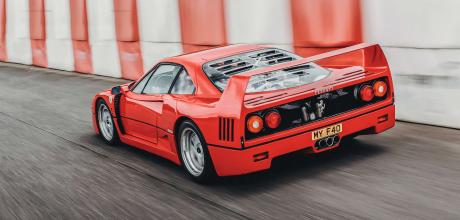1987 Ferrari F40
And so we arrive at a notable benchmark on this journey: the Ferrari F40 was the first production car to exceed the magic ‘double-ton’. You could argue that the F40 owes its existence to healthy opportunism rather than a well-planned marketing strategy. Ferrari’s sales had faltered in the early 1980s, with fears that its products were turning ‘soft’ under Fiat’s corporate blanket.
A quick solution was needed to turn the tide and, in 1984, Maranello engineer Nicola Materazzi believed that he had one. His plan was to use Group B rallying as a testbed for a more hardcore road product. Approval was given, which resulted in a skunkworks development of what became the 288GTO, with the 288 Evoluzione its competition flag-bearer. Alas, by the time the programme was complete Group B had been dissolved and, while the 288GTO successfully expunged any lingering doubts about Ferrari’s softness, there was clearly scope to do more.
Much more, in fact. The F40 replaced the 288GTO in 1987 and, despite the new machine adopting a slightly larger (2936cc versus 2855cc) version of the GTO’s twin-turbocharged V8, it was set to be an altogether more high-tech, uncompromising and brutally fast proposition.
Weight reduction and aerodynamics were the F40 development team’s watchwords from the start. A clean-sheet design by Leonardo Fioravanti at Pininfarina housed the F40’s mighty powerplant in a tubular spaceframe chassis, clothed with bonded Kevlar panels and carbonfibre door skins, bonnet and boot panels.
All but the essentials were stripped from the cabin, leaving ultra-lightweight bucket seats, a pared-down, felt-covered dash and pull-cords for doorhandles, all contributing to a sylphlike 2723lb kerbweight. Wind-tunnel testing resulted in a relatively low (for a sports car) Cd figure of 0.34, and 15,000 miles of testing at Nardò, including 48 hours at a 187mph average, ironed out any high-speed stability issues.
Engine power was substantially increased versus the 288GTO, with 478bhp at a typically high 7000rpm. But a hefty 426lb ft of torque at a relatively low 4000rpm was a portend to the prodigious mid-range urge on tap. As with the body and interior, weight was shed from the powertrain, with its sump, cylinder-head covers, intake manifolds and gearbox bellhousing all cast from ultra-expensive magnesium.
Enzo Ferrari, fully behind the programme, demanded the car be ready within 11 months, in time for the company’s 40th anniversary, hence its eventual moniker. It turned out to be the last car Enzo approved, and with rumours already rife about his ill health (he died the following year), it was clear demand would outstrip the proposed 400-car build. By 1992, when production ceased, 1315 F40s had been sold.
The 1990 example with us today belongs to Wolfrace Wheels founder Barry Treacy, who has owned it almost from new.
Lifting the F40’s rear clam reveals that it is simply a racing car masquerading as something with legal access to a public road. Huge 335-section tyres on 17in rims suspended by exquisite-looking unequal-length upper and lower wishbones dominate the view. The 90º V8 sits ahead of them, nestled close to the bulkhead with the turbochargers’ two massive intercoolers partly shrouding it. You could gaze at it for ever.
But we’re here to drive it on track. Step over the high, carbonfibre-covered sill and drop into the Sabelt bucket seat. The drilled aluminium pedals are slightly offset to the right (all F40s are left-hand drive), but overall the driving position is comfortable, if a little long-armed. A simple binnacle containing speed, revs, water temperature and turbo boost is supplemented by three smaller dials in the centre of the dashboard for oil temperature and pressure, and fuel. There really isn’t much else to distract you.
Twist the key and the V8 springs into life, more refined than you expect it to be. It demands plenty of revs to pull away, though, not helped by the heavy and quite abrupt clutch. Steering through the unassisted rim remains weighty even after you’ve gathered speed, but it’s a delight: high-geared, taut and alive with feel. As you gradually build speed through the bends, it’s a real confidence-giver.
Then it’s time to unleash the F40’s near- 500bhp arsenal. Turbo lag? Nowhere near what you might expect, with the drama building progressively after 3000rpm before reaching quite absurd levels of thrust as the twin IHI turbos spool towards their maximum 1.1bar boost from about 3800rpm. The soundtrack has the aural appeal of an older Formula One V8, but it is accompanied between gearshifts by the loudest wastegate ‘whoosh’ I’ve experienced this side of a modified Mitsubishi Evo VI.
Subjectively, apart from the McLaren, nothing else here today feels as damned fierce as the F40 in its mid-range. Not for the fainthearted, perhaps, but the perfect tonic for those accusations of Ferrari softness.
Thanks to Will Brown at the Ferrari Owners’ Club of Great Britain (ferrariownersclub.co.uk)
TECHNICAL DATA FILE 1987 Ferrari F40
- Sold/number built 1987-1992/1315
- Engine all-alloy, dohc-per-bank 2936cc V8, with electronic fuel injection and twin IHI turbochargers
- Max power 478bhp @ 7000rpm
- Max torque 426lb ft @ 4000rpm
- Transmission five-speed manual transaxle, RWD
- Suspension independent, by unequallength wishbones, coil springs, telescopic dampers and anti-roll bar f/r
- Steering rack and pinion
- Brakes ventilated discs
- Weight 2723lb (1235kg)
- 0-60mph 4.1 secs
- Top speed 201mph
- Price new £193,000 (1987)
- Price now £1-1.75m
FASTEST FEMALE ATHLETE21.32mph
Nowadays Usain Bolt is the name we associate with ultimate human speed, but in 1988 Florence Griffith Joyner became the fastest woman over 100m when she hit 21.32mph at the US Olympic trials, covering the distance in a barely believable 10.49 secs. The record still stands. For context, 24 years later Bolt was just 0.9 secs and 2mph faster.

Clockwise: steering is heavy but inspires confidence; essentials only in spartan cockpit; 0.34Cd aids top speed; 478bhp twin-turbo V8


